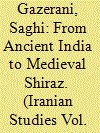|
|
|
Sort Order |
|
|
|
Items / Page
|
|
|
|
|
|
|
| Srl | Item |
| 1 |
ID:
158705


|
|
|
|
|
| Summary/Abstract |
This article explores the poetry of Shah Ismāʿīl Safavī (d. 1524), the founder of the Safavid dynasty of Iran. Established as an important historical source by Vladimir Minorsky during World War II, the issues surrounding the poetic corpus of Shah Ismāʿīl have continued to attract the attention of historians of the Safavids. With examples from the earliest and most authentic manuscript, the idea of viewing this body of works as literary sources versus political propaganda is discussed in this article.
|
|
|
|
|
|
|
|
|
|
|
|
|
|
|
|
| 2 |
ID:
158709


|
|
|
|
|
| Summary/Abstract |
This essay examines the graphic memoir An Iranian Metamorphosis, by the acclaimed cartoonist Mana Neyestani, in the context of Iranian diaspora literature, particularly the genre of comics. Neyestani’s book is analyzed for its engagement with the politics of exile literature, and its attempt at challenging a two-dimensional view of the political discourse, in which the ethical boundaries of pro- and anti-government are overtly simple. The essay focuses on the book’s narrative techniques that exhibit a complex awareness of what is anticipated from a representative work of Iranian exile memoir, and the way it negotiates its own narrative politics. To clarify the arguments, several comparative examples are drawn from two well-known graphic narratives by Iranian diaspora authors, Marjane Satrapi’s Persepolis, and Amir and Khalil’s Zahra’s Paradise.
|
|
|
|
|
|
|
|
|
|
|
|
|
|
|
|
| 3 |
ID:
158704


|
|
|
|
|
| Summary/Abstract |
The figure of the ascetic cat, one known for his pretense to piety, appears throughout the medieval Persian literature. This study examines the movement of this literary motif along the Silk Road where Buddhism and Manichaeism facilitated its transmission into the nascent Islamic civilization. The study traces the possible paths of their journey by examining both the literary transmission of two anecdotes of the ascetic cat from India to Shiraz, as well as by considering the historical context for such transmission.
|
|
|
|
|
|
|
|
|
|
|
|
|
|
|
|
| 4 |
ID:
158707


|
|
|
|
|
| Summary/Abstract |
By bringing to bear previously unstudied Soviet archival documents and conducting firsthand interviews with former diplomats, the article traces the ways in which the Soviet Union sought out opportunities to reinvigorate deteriorated Soviet‒Iranian ties through cultural organizations and events in Iran during the decades following World War II. A variety of Soviet cultural representatives—from wrestlers to classical musicians to scholars of Iranian literature—were marshaled for this effort, which bore unexpected fruit considering the modest expectations of the Soviet leadership, ideological differences between the two countries, and increasingly dominant US cultural projection. The connections between cultural ties and state goals, Iranian perceptions of Russia, and the Soviet/Russian sympathies of some members of the shah’s government are among sub-themes examined.
|
|
|
|
|
|
|
|
|
|
|
|
|
|
|
|
| 5 |
ID:
158706


|
|
|
|
|
| Summary/Abstract |
The famous Persian version of the Jāmiʿ al-Tawārikh (Hazine 1654) has never been studied with the care it deserves. Since its transcription was completed a year before Rashid al-Din’s execution, it remained unfinished while approximately seven illustrations were inserted into it, and the locations of other illustrations were left blank. Careful examination of the manuscript reveals that almost all of the empty spaces left for narrative illustrations were painted during the last decades of the fourteenth century. Having decided to improve the quality of the manuscript, the kitābkhāna of Shāhrukh, in the fifteenth century, completed the missing passages of text and restored or overpainted some of its illustrations. The dedicatory inscription of Farhād Khān Qarāmānlu indicates that the manuscript was refurbished again in the Safavid period. The last artistic additions to the manuscript were overpainting an illustration and insertion of two illuminated friezes in the Ottoman Istanbul. This paper, which is a result of close examination of the original manuscript, explains the complicated life history of the book.
|
|
|
|
|
|
|
|
|
|
|
|
|
|
|
|
| 6 |
ID:
158708


|
|
|
|
|
| Summary/Abstract |
This paper explores the ever-shifting symbiosis between the village motif, social justice and populist politics in Iran over the past three decades. The village has remained a recurring motif in Persian literature, employed by a variety of writers and state institutions for a range of means. As a symbol, it has been a conduit into which any ideology can be poured; the village allegory can be manipulated to both condemn and support the official policies of the state. A comparison of Iran’s pre- and post-revolutionary literature sheds light on the ways the state literati perpetuated an idealized picture of the village as an authentic, sacred space, increasingly associated with religious nationalism during the 1980s. The paper examines the key socio-political influences on the evolution of the pastoral motif, the work of state-sponsored official poets, and the impact of the village on the cultural doctrine of the Islamic Republic.
|
|
|
|
|
|
|
|
|
|
|
|
|
|
|
|
|
|
|
|
|